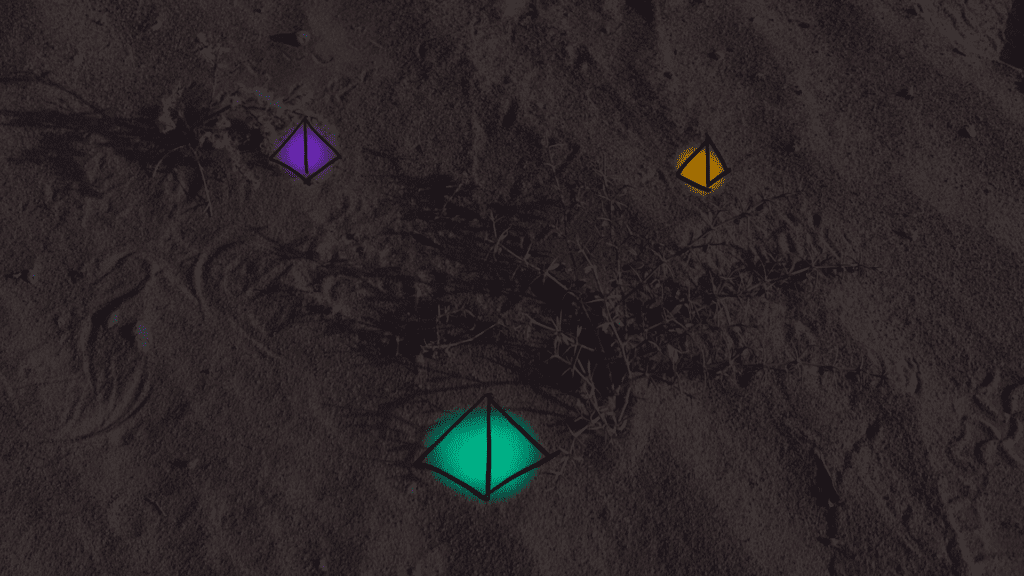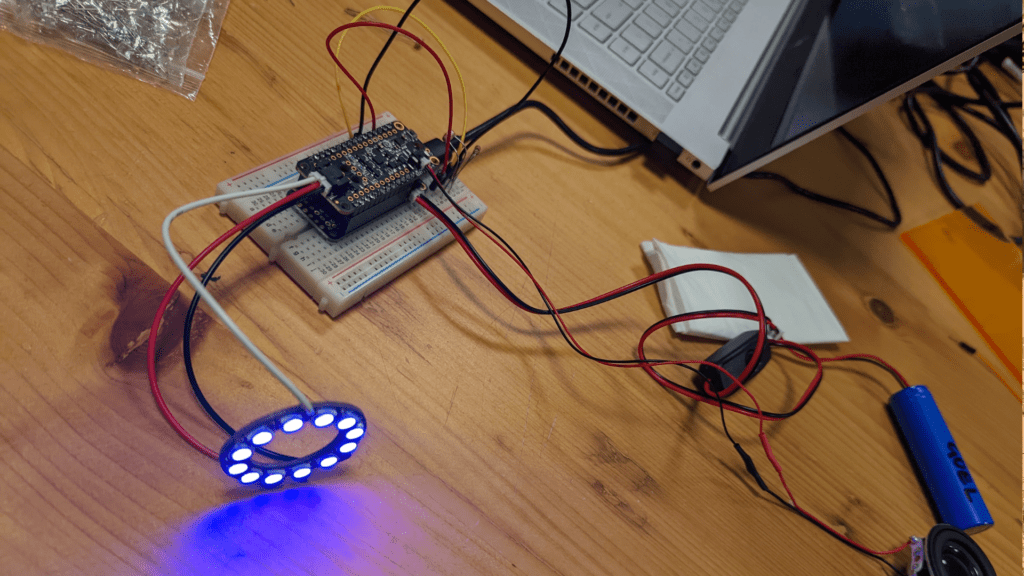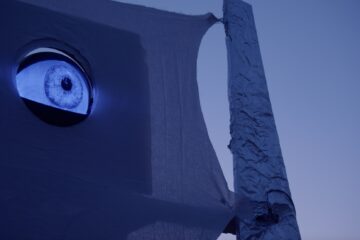While deserts are often associated as silent, vast, empty, and isolated, they are misunderstood as without life. The When Life Meets Life Interactive Pyramids installation would like to show that the desert is filled with diverse forms of life that react to life differently according to different circumstances. The installation is composed of three pyramids placed among bushes that react to shadows and light, producing sound in the day and light at night. Each of the three pyramids will express different sounds and colors of light when they are interacted with. The desert context in our project provides an extreme environment in hopes to stimulate thinking and exploration of possibilities to redefine what life can be.
Overview Sketch

Inspiration
Deserts are often misunderstood to be quiet, isolated places without life. However, in this Desert Media Art class, and especially after the Dubai Desert Conservation Reserve trip, we realized that the desert is filled with diverse forms of life that react to life differently according to different circumstances. Life in the desert is just another form of nature, another ecosystem. Our assumption of the lack of life is due to our narrow view of what life is. We aim to break this myth about the desert by showcasing the abundance of life present in this ecosystem. This is how we landed on the idea of making Interactive Pyramids. The title “When life meets life” represents how life in the interactive pyramids reacts to life differently according to its different environments, such as the change in light between day and night.
Desert Context

This project is specifically made for the desert environment as the installation itself is a metaphor for the alternative and diverse life forms in the desert. Just like the desert, although it might remain still without movement, it still reacts to life by interacting with its surrounding through light and sound. Inspired by the various life forms in the desert, the pyramids interact with life differently between day and night. Hence, the context is particularly important as our work is meant to be discovered in an assumed lifeless environment to express the liveliness of the desert. The installation’s different responses in the day and night reflect how life presents itself in relation to light.
Interaction Design
The interactive pyramids express their life by reacting differently to the amount of light during the day and night.
Day (Shadows)
During the day, when life passes and casts shadows upon the pyramids, the pyramids react with sound, each pyramid with different notes.
Night (Light)
During the night, when explorers search for life and cast light upon the pyramids, the pyramids respond back with light as well as sound – each pyramid with different colors and musical notes.
These lights and sounds are how our pyramids will catch the attention of the audience in the desert and encourage the users to come engage with it further.
Technical Implementation

- The entire outer layer of the structure will be modeled and 3D-printed.
- Each pyramid will contain neo-pixels, some light sensors, and a speaker on top of an M4 featherboard.
- The light sensors are connected to each of the 4 walls in the pyramid. They sense a drastic change in light and which then triggers a response in the neo-pixel and the speaker.
- During the day, when shadows are cast upon the pyramids, the light sensor senses a change in light intensity, thereby recording movement and producing a sound to signal the observer.
- During the night, explorers will interact using light: for e.g wear a band of neo-pixels on their wrists and flash light onto the pyramids in the desert environment. The light sensor again responds to the change in intensity of light based on a specified threshold value by glowing and producing a specific music note that is relayed through the speaker.
- The M4 feathers in the three pyramids are programmed to produce sounds that coherently make different musical chords and the color of lights in the neo-pixel change with each interaction.
Progress Documentation
We started by thinking about the physical design of our project. Initially, we planned to create interactive stones representing the theme of “Desert Stones” with a flower in each of them to represent life. The stone would be discovered when it glows upon detecting a change in light and then opens to reveal a flower inside it upon being touched. We made a small prototype to take with us on our desert trip and see how our project looks in a real desert environment. When we tested the prototype during the night before, we realized that the glowing effect had a really good aesthetic appeal that would be lost if we were to go forward with opening the stone idea. The glowing effect felt more powerful in itself in symbolizing life. Having our audience pick the pyramid up, touch it and reveal a flower would become a bit of an overkill and take away from the aesthetic of the glowing pyramid. There was something in the subtle glow and the simplicity of the prototype that all of us liked and decided that we did not want to overcomplicate it as it would divert the attention and message of our artwork. When we placed our 3D-printed pyramid in the desert, we also realized that the interaction does not only have to be limited during the night. Just as our prototype responded to changes in light during the night, it also responded to shadows during the day. This gave our project a new dimension – an added layer to explore further.
We are currently working on the implementation of this new idea. Even though we pivoted from our initial idea, our fundamental vision of representing life in the desert is still the same. This is the progress that we have made so far in terms of making the initial project prototype:
- We started by modeling the shape of a pyramid. We tried around with different sizes so as to accommodate the different components inside. We thought of initially using the transparent filament to print, but then realized that the transparency wasn’t helpful in terms of hiding the wires and the components inside the pyramid and neither did it help with the proper dispersion of light. Therefore we decided on using tough white PLA for printing instead.
- We used a photoresistor and plotted the light intensity values that we got from different levels of light shining on the surface of the sensor. We tried out the photoresistor even inside the pyramid and tried capturing a threshold for a change in light intensity (instead of just intensity). The response from the pyramid was triggered only when the change in two consecutive values from the light sensor was beyond the particular threshold. Focusing on the change in light intensity instead of just light intensity made our installation more robust and also led to it detecting responses from shadows.
- After a lot of trial and error, when we finally narrowed down a good threshold value (that we later also tested in the desert environment), we went ahead to integrate the neo-pixel and the speaker. We uploaded the libraries and the code required to run those in separate files and imported them to the main copy.py file as functions. Over time we have tried to reduce the delay between the trigger and the two responses as much as possible.
- We have also improved our pyramid design to make the opening wider to facilitate the assembly of components and created a mechanism to snap the two parts shut.
Besides achieving technical competence, we have started thinking about the emotions and feelings our project must convey and appropriately choosing the sounds and colors to emote that. A lot of thought must go into the artistic implementation and having the project convey the message on its own.
Project Implementation
We have divided the implementation into different technical components. For the exterior design of the installation, the 3D-printed prototype we have created as a sample works well. We appreciate the simplicity and the pyramid’s symbolism – life after death – which represents the diverse forms of life. For the other two pyramids, we would like to 3D-print the same model but in different sizes. We also experimented with light sensors, neo-pixels, and speakers. While the desert is generally silent, we need to test whether the speaker we have is audible enough. If not, we will need to discover ways to increase the volume, such as making the exterior design thinner for sound to permeate more easily. We will also consider making the exterior design thinner to allow light to permeate through more easily. We will essentially build off of our current exterior design for the rest of the project.
We also need to further design and implement the interaction with the pyramids. For the day, we will design how shadows will trigger the pyramids’ reaction. We are exploring different ways of casting shadows, such as through images or simply silhouettes of humans. As for the pyramid’s reaction, we will test out different musical notes for different pyramids so that they can harmonize with each other. A considerable amount of brainstorming, implementation, and testing would be required for achieving the perfect musical chords that sync harmoniously with the perfect shades of light. For the night, we will create a separate neo-pixel wristband to cast light on the pyramid. We will start by testing out neo-pixels that are able to trigger reactions from the pyramid. We will then design a wristband to surround the neo-pixel so audience members can wear the band on their wrists and interact with the pyramids. We will also make efforts to make sure the wristband is light and easy to wear. With technical components ready, including the 3D-printed exterior model, light sensor, pyramid neo-pixels, speakers, and wristband neo-pixels, we will duplicate and group them to form three pyramids. We plan to conduct a number of rounds of testing, both indoors and outdoors for cohesiveness before taking our installation to the field.


